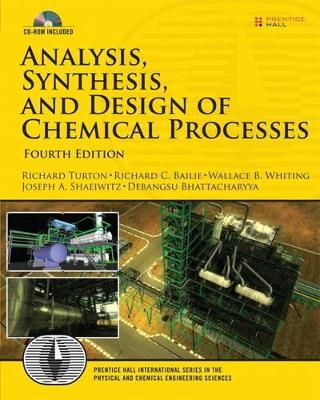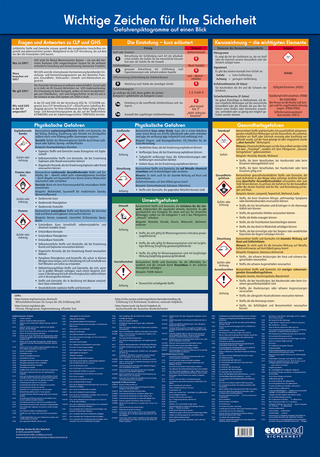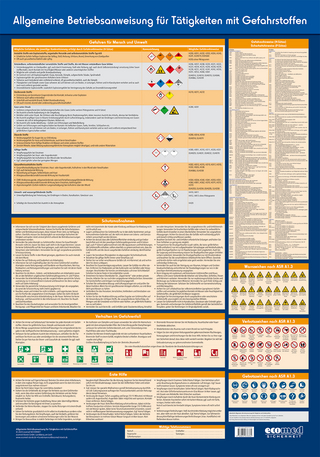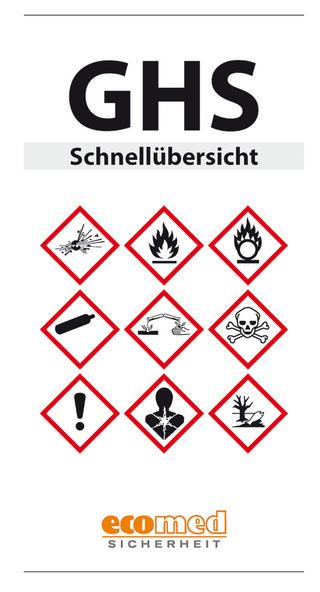
Analysis, Synthesis and Design of Chemical Processes
Prentice Hall
978-0-13-261812-0 (ISBN)
- Titel ist leider vergriffen;
keine Neuauflage - Artikel merken
More than ever, effective design is the focal point of sound chemical engineering. Analysis, Synthesis, and Design of Chemical Processes, Fourth Edition, presents design as a creative process that integrates both the big picture and the small details–and knows which to stress when, and why. Realistic from start to finish, this updated edition moves readers beyond classroom exercises into open-ended, real-world process problem solving. The authors introduce integrated techniques for every facet of the discipline, from finance to operations, new plant design to existing process optimization.
This fourth edition adds new chapters introducing dynamic process simulation; advanced concepts in steady-state simulation; extensive coverage of thermodynamics packages for modeling processes containing electrolyte solutions and solids; and a concise introduction to logic control. “What You Have Learned” summaries have been added to each chapter, and the text’s organization has been refined for greater clarity.
Coverage Includes
Conceptualization and analysis: flow diagrams, batch processing, tracing, process conditions, and product design strategies
Economic analysis: capital and manufacturing costs, financial calculations, and profitability analysis
Synthesis and optimization: principles, PFD synthesis, simulation techniques, top-down and bottom-up optimization, pinch technology, and software-based control
Advanced steady-state simulation: goals, models, solution strategies, and sensitivity and optimization studies
Dynamic simulation: goals, development, solution methods, algorithms, and solvers
Performance analysis: I/O models, tools, performance curves, reactor performance, troubleshooting, and “debottlenecking”
Societal impact: ethics, professionalism, health, safety, environmental issues, and green engineering
Interpersonal and communication skills: improving teamwork and group effectiveness
This title draws on more than fifty years of innovative chemical engineering instruction at West Virginia University and the University of Nevada, Reno. It includes suggested curricula for single-semester and year-long design courses, case studies and practical design projects, current equipment cost data, and extensive preliminary design information that can be used as the starting point for more detailed analyses.
About the CD-Rom and Web Site
The CD contains the newest version of CAPCOST, a powerful tool for evaluating fixed capital investment, full process economics, and profitability. The heat exchanger network software, HENSAD, is also included. The CD also contains an additional appendix presenting preliminary design information for fifteen key chemical processes, including four new to this edition: shift reaction; acid-gas removal via physical solvent; H2S removal from a gas stream using the Claus process; and coal gasification. The CD also includes six additional projects, plus chapters on outcomes assessment, written and oral communications, and a written report case study. Sixty additional projects and twenty-four more problems are available at www.che.cemr.wvu.edu/publications/projects.
Richard Turton is professor of chemical engineering and professor in the Statler College of Engineering and Mineral Resources at West Virginia University. He has taught WVU’s senior design course for more than twenty-five years. Richard C. Bailie, professor emeritus at WVU, taught chemical engineering design for more than twenty years. He has extensive experience in process evaluation, pilot plant operation, and plant startup. Wallace B. Whiting, professor emeritus at the University of Nevada, Reno, has practiced and taught chemical process design for more than twenty-four years. Joseph A. Shaeiwitz has been involved in WVU’s senior design sequence and sophomore- and junior-level integrated design projects for twenty years. Debangsu Bhattacharyya, associate professor in the department of chemical engineering at WVU, has worked in computer-aided simulation, design, construction, and in the operation of a large petroleum refinery for more than ten years.
Material on the CD-ROM xix Preface xxiii
About the Authors xxvii
List of Nomenclature xxix
Section I: Conceptualization and Analysis of Chemical Processes 1
Chapter 1: Diagrams for Understanding Chemical Processes 3
What You Will Learn 3
1.1 Block Flow Diagram (BFD) 5
1.2 Process Flow Diagram (PFD) 8
1.3 Piping and Instrumentation Diagram (P&ID) 21
1.4 Additional Diagrams 26
1.5 Three-Dimensional Representation of a Process 27
1.6 The 3-D Plant Model 35
1.7 Operator and 3-D Immersive Training Simulators 37
1.8 Summary 43
What You Should Have Learned 43
References 44
Short Answer Questions 44
Problems 44
Chapter 2: The Structure and Synthesis of Process Flow Diagrams 49
What You Will Learn 49
2.1 Hierarchy of Process Design 49
2.2 Step 1–Batch versus Continuous Process 50
2.3 Step 2–The Input/Output Structure of the Process 54
2.4 Step 3–The Recycle Structure of the Process 64
2.5 Step 4–General Structure of the Separation System 78
2.6 Step 5–Heat-Exchanger Network or Process Energy Recovery System 78
2.7 Information Required and Sources 78
2.8 Summary 78
What You Should Have Learned 80
References 80
Short Answer Questions 81
Problems 81
Chapter 3: Batch Processing 87
What You Will Learn 87
3.1 Design Calculations for Batch Processes 87
3.2 Gantt Charts and Scheduling 93
3.3 Nonoverlapping Operations, Overlapping Operations, and Cycle Times 94
3.4 Flowshop and Jobshop Plants 97
3.5 Product and Intermediate Storage and Parallel Process Units 102
3.6 Design of Equipment for Multiproduct Batch Processes 107
3.7 Summary 109
What You Should Have Learned 110
References 110
Short Answer Questions 110
Problems 110
Chapter 4: Chemical Product Design 115
What You Will Learn 115
4.1 Strategies for Chemical Product Design 116
4.2 Needs 117
4.3 Ideas 119
4.4 Selection 120
4.5 Manufacture 122
4.6 Batch Processing 123
4.7 Economic Considerations 123
4.8 Summary 123
What You Should Have Learned 124
References 124
Chapter 5: Tracing Chemicals through the Process Flow Diagram 125
What You Will Learn 125
5.1 Guidelines and Tactics for Tracing Chemicals 125
5.2 Tracing Primary Paths Taken by Chemicals in a Chemical Process 126
5.3 Recycle and Bypass Streams 132
5.4 Tracing Nonreacting Chemicals 135
5.5 Limitations 135
5.6 Written Process Description 136
5.7 Summary 137
What You Should Have Learned 137
Problems 138
Chapter 6: Understanding Process Conditions 139
What You Will Learn 139
6.1 Conditions of Special Concern for the Operation of Separation and Reactor Systems 140
6.2 Reasons for Operating at Conditions of Special Concern 142
6.3 Conditions of Special Concern for the Operation of Other Equipment 146
6.4 Analysis of Important Process Conditions 150
6.5 Summary 157
What You Should Have Learned 157
References 158
Short Answer Questions 158
Problems 158
Section II: Engineering Economic Analysis of Chemical Processes 161
Chapter 7: Estimation of Capital Costs 163
What You Will Learn 163
7.1 Classifications of Capital Cost Estimates 164
7.2 Estimation of Purchased Equipment Costs 167
7.3 Estimating the Total Capital Cost of a Plant 172
7.4 Summary 198
What You Should Have Learned 198
References 198
Short Answer Questions 199
Problems 200
Chapter 8: Estimation of Manufacturing Costs 203
What You Will Learn 203
8.1 Factors Affecting the Cost of Manufacturing a Chemical Product 203
8.2 Cost of Operating Labor 208
8.3 Utility Costs 209
8.4 Raw Material Costs 223
8.5 Yearly Costs and Stream Factors 225
8.6 Estimating Utility Costs from the PFD 225
8.7 Cost of Treating Liquid and Solid Waste Streams 228
8.8 Evaluation of Cost of Manufacture for the Production of Benzene via the Hydrodealkylation of Toluene 228
8.9 Summary 229
What You Should Have Learned 230
References 230
Short Answer Questions 230
Problems 231
Chapter 9: Engineering Economic Analysis 233
What You Will Learn 233
9.1 Investments and the Time Value of Money 234
9.2 Different Types of Interest 238
9.3 Time Basis for Compound Interest Calculations 240
9.4 Cash Flow Diagrams 241
9.5 Calculations from Cash Flow Diagrams 245
9.6 Inflation 250
9.7 Depreciation of Capital Investment 253
9.8 Taxation, Cash Flow, and Profit 259
9.9 Summary 262
What You Should Have Learned 262
References 262
Short Answer Questions 263
Problems 263
Chapter 10: Profitability Analysis 269
What You Will Learn 269
10.1 A Typical Cash Flow Diagram for a New Project 269
10.2 Profitability Criteria for Project Evaluation 271
10.3 Comparing Several Large Projects: Incremental Economic Analysis 279
10.4 Establishing Acceptable Returns from Investments: The Concept of Risk 282
10.5 Evaluation of Equipment Alternatives 283
10.6 Incremental Analysis for Retrofitting Facilities 289
10.7 Evaluation of Risk in Evaluating Profitability 293
10.8 Profit Margin Analysis 310
10.9 Summary 311
What You Should Have Learned 311
References 312
Short Answer Questions 312
Problems 312
Section III: Synthesis and Optimization of Chemical Processes 327
Chapter 11: Utilizing Experience-Based Principles to Confirm the Suitability of a Process Design 331
What You Will Learn 331
11.1 The Role of Experience in the Design Process 332
11.2 Presentation of Tables of Technical Heuristics and Guidelines 335
11.3 Summary 338
What You Should Have Learned 356
References 356
Problems 356
Chapter 12: Synthesis of the PFD from the Generic BFD 357
What You Will Learn 357
12.1 Information Needs and Sources 358
12.2 Reactor Section 360
12.3 Separator Section 362
12.4 Reactor Feed Preparation and Separator Feed Preparation Sections 377
12.5 Recycle Section 378
12.6 Environmental Control Section 378
12.7 Major Process Control Loops 379
12.8 Flow Summary Table 379
12.9 Major Equipment Summary Table 380
12.10 Summary 380
What You Should Have Learned 380
References 381
Problems 382
Chapter 13: Synthesis of a Process Using a Simulator and Simulator Troubleshooting 385
What You Will Learn 385
13.1 The Structure of a Process Simulator 386
13.2 Information Required to Complete a Process Simulation: Input Data 389
13.3 Handling Recycle Streams 401
13.4 Choosing Thermodynamic Models 403
13.5 Case Study: Toluene Hydrodealkylation Process 414
13.6 Electrolyte Systems Modeling 416
13.7 Solids Modeling 429
What You Should Have Learned 434
Appendix 13.1 Calculation of Excess Gibbs Energy for Electrolyte Systems 434
Appendix 13.2 Steps to Build a Model of a Distillation Column for an Electrolyte System Using a Rate-Based Simulation with a Film Model for Mass Transfer, the Parameters Required at Each Stage, and Possible Sources of These Parameters 437
13.8 Summary 440
References 441
Short Answer Questions 444
Problems 444
Chapter 14: Process Optimization 451
What You Will Learn 451
14.1 Background Information on Optimization 451
14.2 Strategies 457
14.3 Topological Optimization 461
14.4 Parametric Optimization 467
14.5 Lattice Search Techniques versus Response Surface Techniques 478
14.6 Process Flexibility and the Sensitivity of the Optimum 479
14.7 Optimization in Batch Systems 479
14.8 Summary 487
What You Should Have Learned 487
References 487
Short Answer Questions 488
Problems 488
Chapter 15: Pinch Technology 499
What You Will Learn 499
15.1 Introduction 499
15.2 Heat Integration and Network Design 500
15.3 Composite Temperature-Enthalpy Diagram 514
15.4 Composite Enthalpy Curves for Systems without a Pinch 516
15.5 Using the Composite Enthalpy Curve to Estimate Heat-Exchanger Surface Area 517
15.6 Effectiveness Factor (F) and the Number of Shells 521
15.7 Combining Costs to give the EAOC for the Network 526
15.8 Other Considerations 527
15.9 Heat-Exchanger Network Synthesis Analysis and Design (HENSAD) Program 532
15.10 Mass-Exchange Networks 532
15.11 Summary 541
What You Should Have Learned 542
References 542
Short Answer Questions 543
Problems 543
Chapter 16: Advanced Topics Using Steady-State Simulators 551
What You Will Learn 551
16.1 Why the Need for Advanced Topics in Steady-State Simulation? 552
16.2 User-Added Models 552
16.3 Solution Strategy for Steady-State Simulations 562
16.4 Studies with the Steady-State Simulation 581
16.5 Estimation of Physical Property Parameters 586
16.6 Summary 589
What You Should Have Learned 590
References 590
Short Answer Questions 591
Problems 592
Chapter 17: Using Dynamic Simulators in Process Design 601
What You Will Learn 601
17.1 Why Is There a Need for Dynamic Simulation? 602
17.2 Setting Up a Dynamic Simulation 603
17.3 Dynamic Simulation Solution Methods 618
17.4 Process Control 624
17.5 Summary 632
What You Should Have Learned 632
References 633
Short Answer Questions 633
Problems 634
Chapter 18: Regulation and Control of Chemical Processes with Applications Using Commercial Software 641
What You Will Learn 641
18.1 A Simple Regulation Problem 642
18.2 The Characteristics of Regulating Valves 643
18.3 Regulating Flowrates and Pressures 646
18.4 The Measurement of Process Variables 649
18.5 Common Control Strategies Used in Chemical Processes 649
18.6 Exchanging Heat and Work between Process and Utility Streams 660
18.7 Logic Control 666
18.8 Advanced Process Control 669
18.9 Case Studies 670
18.10 Putting It All Together: The Operator Training Simulator (OTS) 676
18.11 Summary 677
What You Should Have Learned 677
References 678
Problems 678
Section IV: Analysis Of Process Performance 683
Chapter 19: Process Input/Output Models 685
What You Will Learn 685
19.1 Representation of Process Inputs and Outputs 686
19.2 Analysis of the Effect of Process Inputs on Process Outputs 689
19.3 A Process Example 690
19.4 Summary 691
What You Should Have Learned 692
Problems 692
Chapter 20: Tools for Evaluating Process Performance 693
What You Will Learn 693
20.1 Key Relationships 693
20.2 Thinking with Equations 694
20.3 Base-Case Ratios 696
20.4 Analysis of Systems Using Controlling Resistances 698
20.5 Graphical Representations 700
20.6 Summary 704
What You Should Have Learned 705
References 705
Problems 705
Chapter 21: Performance Curves for Individual Unit Operations 707
What You Will Learn 707
21.1 Application to Heat Transfer 709
21.2 Application to Fluid Flow 714
21.3 Application to Separation Problems 728
21.4 Summary 740
What You Should Have Learned 741
References 741
Short Answer Questions 741
Problems 743
Chapter 22: Performance of Multiple Unit Operations 749
What You Will Learn 749
22.1 Analysis of a Reactor with Heat Transfer 749
22.2 Performance of a Distillation Column 754
22.3 Performance of a Heating Loop 759
22.4 Performance of the Feed Section to a Process 765
22.5 Summary 768
What You Should Have Learned 769
References 769
Short Answer Questions 769
Problems 769
Chapter 23: Reactor Performance 785
What You Will Learn 785
23.1 Production of Desired Product 786
23.2 Reaction Kinetics and Thermodynamics 788
23.3 The Chemical Reactor 791
23.4 Heat Transfer in the Chemical Reactor 796
23.5 Reactor System Case Studies 799
23.6 Summary 812
What You Should Have Learned 813
References 813
Short Answer Questions 813
Problems 814
Chapter 24: Process Troubleshooting and Debottlenecking 819
What You Will Learn 819
24.1 Recommended Methodology 821
24.2 Troubleshooting Individual Units 825
24.3 Troubleshooting Multiple Units 831
24.4 A Process Troubleshooting Problem 836
24.5 Debottlenecking Problems 840
24.6 Summary 841
What You Should Have Learned 841
References 841
Problems 841
Section V: The Impact of Chemical Engineering Design on Society 853
Chapter 25: Ethics and Professionalism 855
What You Will Learn 855
25.1 Ethics 856
25.2 Professional Registration 874
25.3 Legal Liability 879
25.4 Business Codes of Conduct 880
25.5 Summary 881
What You Should Have Learned 881
References 882
Problems 882
Chapter 26: Health, Safety, and the Environment 885
What You Will Learn 885
26.1 Risk Assessment 886
26.2 Regulations and Agencies 888
26.3 Fires and Explosions 898
26.4 Process Hazard Analysis 900
26.5 Chemical Safety and Hazard Investigation Board 909
26.6 Inherently Safe Design 909
26.7 Summary 910
26.8 Glossary 910
What You Should Have Learned 912
References 912
Problems 913
Chapter 27: Green Engineering 915
What You Will Learn 915
27.1 Environmental Regulations 915
27.2 Environmental Fate of Chemicals 916
27.3 Green Chemistry 919
27.4 Pollution Prevention during Process Design 920
27.5 Analysis of a PFD for Pollution Performance and Environmental Performance 922
27.6 An Example of the Economics of Pollution Prevention 923
27.7 Life Cycle Analysis 924
27.8 Summary 926
What You Should Have Learned 926
References 926
Problems 927
Section VI: Interpersonal And Communication Skills 929
Chapter 28: Teamwork 931
What You Will Learn 931
28.1 Groups 931
28.2 Group Evolution 940
28.3 Teams and Teamwork 943
28.4 Misconceptions 945
28.5 Learning in Teams 946
28.6 Other Reading 947
28.7 Summary 948
What You Should Have Learned 949
References 949
Problems 949
Appendix A: Cost Equations and Curves for the CAPCOST Program 951
A.1 Purchased Equipment Costs 951
A.2 Pressure Factors 969
A.3 Material Factors and Bare Module Factors 973
References 982
Index 983
| Erscheint lt. Verlag | 28.7.2020 |
|---|---|
| Verlagsort | Upper Saddle River |
| Sprache | englisch |
| Maße | 209 x 259 mm |
| Gewicht | 1842 g |
| Themenwelt | Naturwissenschaften ► Chemie ► Technische Chemie |
| Technik ► Umwelttechnik / Biotechnologie | |
| ISBN-10 | 0-13-261812-5 / 0132618125 |
| ISBN-13 | 978-0-13-261812-0 / 9780132618120 |
| Zustand | Neuware |
| Haben Sie eine Frage zum Produkt? |
aus dem Bereich


